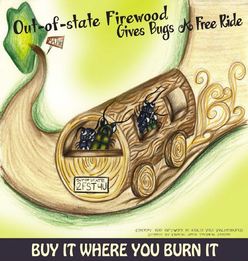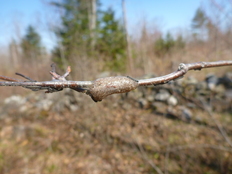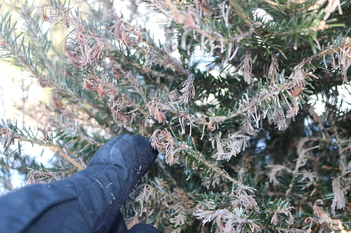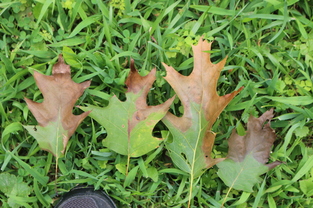Insect & Disease Conditions Update
A printer-friendly version of this report will soon be available on-line from the Conditions Report Index. This is the first Conditions Report
for the 2018 season. The forest health
staff have a busy field season planned and work on several projects has already
begun, despite being well ahead of budbreak. Due to the recent retirement of entomologist,
Charlene Donahue, the forest health staff is temporarily reduced to two
entomologists and one pathologist to serve the needs of the state. Due to this, our subscribers may find that
this publication may not be distributed as frequently and issues may not be as
long in 2018 as in the past. We hope to fill the vacant entomologist position
as soon as possible.
 The beginning of a new season of
outdoor recreation brings new focus to the dangers posed to our forests by
invasive forest pests, often spread by infested firewood. Recreationists and camp owners from
out-of-state must be aware of the threats invasive forest pests pose to Maine’s
natural resources. Currently, the emerald ash borer (EAB) and Asian longhorned
beetle (ALB) are of greatest concern, but there are dozens of other threats to
our forest that can move in or on firewood that the public will be less likely
to recognize. These range from tiny
bullet-shaped beetles and large longhorned beetles, that look nearly identical
to our native beetles, to microscopic fungi.
The message, “use local firewood,” is less complicated than enumerating
hosts and descriptions of some key insects of concern. However, we will
continue to provide information about these few “charismatic megafauna” with
the hopes that you can help us find them, but with the caveat that they are
merely the tip of the iceberg when it comes to new forest threats. Learn to identify those insects, their signs
and symptoms, but keep aware of changes in tree and forest health, and report
concerns beyond the most wanted list.
Public detections are important in finding
these insects in our forest and ornamental trees as quickly as possible.
We also ask the concerned public to help us
spread the word about firewood. Maybe you know a neighbor who looks at a trip
to camp as a frugal and environmentally sensitive alternative to disposal of
suburban tree waste. Consider helping
your neighbor recognize the costs associated with that activity. If a neighborly chat is not enough to
convince him or her to burn the wood immediately, or there is too much wood for
immediate consumption, you can report your concerns to the MFS Forest
Protection Division by phone at 1-800-750-9777 or online at http://www.maine.gov/dacf/mfs/rpt_concerns.html.
Because there is a quarantine on
EAB in most states in the Eastern US, transporting firewood into Maine from
out-of-state is often not only a violation of State rules, but also of Federal
quarantine. Learn more at emeraldashborer.info and www.maine.gov/firewood.
|
Browntail moth (Euproctis chrysorrhoea) – Think
browntail moth is a problem of the coast?
Think again. Coastal areas are
home to the most intense populations of browntail moth, but the known
distribution and intensity of populations is growing. We have reports of significant defoliation
from towns such as Eddington, Etna, Burnham, Belgrade, and Turner. Look at the map below to see if this insect
has been reported in your town. More
importantly, inspect your fruit (apple, crabapple, serviceberry, cherry,
hawthorn and relatives) and oak trees for the overwintering webs. We’re happy to look at photos to confirm or
rule out browntail moth. Submit photos at: https://www.surveymonkey.com/r/btmreport. If you do find webs within reach, there is a
short time left in which populations can be reduced by removing and destroying
the webs (soak in soapy water or burn, see the video resource on our website). Please report your web sightings, especially
outside of heavily infested areas (moderate to high populations on the
map). Our maps are certainly incomplete,
and you can help us make them better.

Emerald Ash Borer (Agrilus planipennis) – Emerald ash borer (EAB) has still not yet been found in Maine, although new infestations have recently been found in our neighboring states and provinces. In the last few weeks, EAB has been found in Vermont in three counties, and they are still delimiting the infestation and considering their quarantine options. Recent finds in Québec and New Hampshire have led to expansion of their quarantine areas. Much more of Maine’s land border with New Hampshire and Quebec now abuts areas quarantined for EAB.
Even though this destructive insect is practically on our doorstep, it is still too early in most of Maine to be treating specimen ash with pesticides to protect them. Experts recommend holding off treatment until the EAB is within 10–15 miles of the trees in question. In the meantime, resources are better spent on inventorying ash and surveying and monitoring for the pest.
 Ash phenology gives us a great opportunity to conduct surveys as hardwood leaves emerge. Because ash trees are among the last to leaf out, they are easily recognized after the leaves of other hardwood have flushed. An ash inventory can be as simple as a windshield survey to determine whether you have a lot of ash to worry about, or just a few. For more in-depth inventories, consider recording location, size, value and likely management approach for each tree. Check out the nhbugs.org site on EAB for some succinct advice on preparing for this pest in areas more than 10 miles from known infestations (http://nhbugs.org/recommendations-homeowners-and-landowners).
 If you are a landowner and have ash
trees on your land, consider creating a girdled trap tree to monitor for
EAB. All trap trees girdled last year
were negative for signs of EAB and efforts have begun this year to girdle trees
to continue monitoring. If you have an ash tree of any species (not mountain
ash) over four inches in diameter at 4.5 feet that you would be willing to
sacrifice as a trap tree, please email Colleen Teerling at colleen.teerling@maine.gov with the
subject line “Trap Tree” and we will help you create a trap tree. More
information can be found on our website.
Photo: Evidence of
woodpecker feeding on ash. Image: Maine
Forest Service
This is one of the best times of year to watch for signs of
EAB. During the winter until the trees
start to leaf out in the spring, woodpeckers often find and feed on
overwintering EAB larvae, which are fat and make good eating at this time of
year. As the birds feed, they flick off
the gray outer bark, and expose the light-blond inner bark, leaving a
distinctive signature (although not unique to woodpeckers feeding on EAB). It is primarily the smaller woodpeckers, like
the hairy and the downy, that feed on EAB; although even smaller birds like
nuthatches do as well. When you are out
and about, watch for signs of woodpecker feeding on ash and let us know if you
see any. If you can, take a picture of
any feeding you see on ash and pass it on to us.
|
 Eastern Tent Caterpillar (Malacosoma
americanum) – Watch for the
developing tents of these hairy caterpillars in cherries and apples in late
April and early May in southern Maine (later as you move farther north). In Maine, this native insect is primarily a
nuisance and aesthetic pest. It does not
significantly impact forest health, but repeated defoliation can affect host
growth and vigor, which can be important on ornamental and orchard trees. On
valued fruit and ornamental trees, you can look for and destroy egg masses of
this caterpillar. Also, monitor for
developing tents on these trees and consider removing them when they are small.
The caterpillars return to their tents in the evening, so this and early
morning are good times to remove tents.
Photo: Eastern tent caterpillar egg mass. Maine Forest Service
|
Ground-Nesting Bees – Beginning in very early spring, solitary ground-dwelling bees
emerge and become active. When they first emerge, they are usually very active,
with much flying around, mating, exploration and nest-building. As people
increase their yard-work activities, they begin to notice the bees. All this
activity by bees can look frightening. However, solitary bees (one nest for
each female, although you may have many nests in one area) are generally
non-aggressive and will not sting unless severely harassed. The males often
look aggressive while they fly around searching for a mate, but they can’t
sting at all. This heightened activity persists for only a week or two, and
then the bees are almost unnoticeable. Ground nesting bees are valuable
pollinators.
Hemlock Woolly Adelgid (Adelges
tsugae) – Hemlock woolly adelgid (HWA) eggs and/or crawlers (mobile stage
of HWA) are now present and will be more-or-less continuously present until
late July or early August. These life-stages can be spread on many items other
than the host trees (clothing, equipment, vehicles, pets, etc.). If possible, postpone work in infested
hemlock stands until August to reduce spread of HWA. Remember that HWA is a quarantined pest. Live, rooted hemlocks and recently cut branch
material pose the highest risks for spreading this pest. Within Maine, all hemlock products may move
freely within the quarantined area.
Roundwood products such as logs and pulp may be moved freely within Maine,
but must be free of foliage. Material with branches, such as chips, moved
outside the quarantine area must go to facilities with agreements to receive
that material. New Hampshire recently eliminated its quarantine on hemlock. Quarantines in other jurisdictions vary.
Spruce budworm (Choristoneura fumiferana)
– Thanks to our cooperators who help augment
survey for this pest. Information about needs for the 2018 season are already
rolling in—please get those to us by the middle of this month so we can plan
for distribution. The full report on 2017 spruce budworm monitoring activities
and current populations in Maine is available on the Maine Spruce Budworm Task
Force website www.sprucebudwormmaine.org. Look
under News & Events. Paper copies are
available by request.
Winter moth (Operophtera brumata) – Defoliation
by winter moth was up in 2017 in comparison to the previous years. Winter moth
caterpillars will be hatching around the same time as red maples begin bloom. It will be some time yet here, especially
with the cool April predicted for Maine. If you banded trees against winter
moth in the fall, you are well prepared to monitor for egg hatch. Search on and below the bands for tiny orange
eggs. These eggs will turn blue just
before hatching. Feel free to report
observations to our office. Winter moth eggs that are exposed on trees can be
killed with horticultural oil, which suffocates the eggs. Oil should be applied
in very late winter or very early spring when temperatures are above 45°
F. Avoid applying oil when temperatures
may dip below freezing for 24–48 hours after application, since cold greatly
increases the risk of causing injury to the plant.
There was good news out of Massachusetts last year, where the
introduced biocontrol Cyzenis albicans appears
to be providing some relief from high winter moth populations. We’ve had both releases and recoveries of the
parasitoid in Maine, and are hopeful for the future in regards to this pest.
 Delphinella shoot blight (Delphinella abietis) affects true firs
(Abies spp.) and is an occasional pest of firs in Christmas tree
plantations and horticultural plantings in Maine. Historically, the disease has
been recorded in several locations throughout Maine and has resulted in some
losses in plantations. Delphinella shoot blight is characterized by blighted
tips, usually affecting early season new growth. At first glance, the damage can
resemble that caused by late frost. Newly affected tips turn a reddish-brown
color and may twist and turn irregularly as they dry (this symptom can also be
mistaken for chemical injury). In time, numerous black fungal spore-producing
structures can be seen on the needles on the dry blighted tips. These needles
persist for a year or more and are the source of reinfection during prolonged
periods of moisture in the following spring/early summer.
Photo: Delphinella
shoot blight symptoms in Penobscot County, Maine in 2018. Maine Forest Service
Any management practices that
encourage air-flow in the vicinity of trees, thus enhancing needle drying
(decreasing the period of needle wetness), may limit disease. Pruning of lower,
infected branches reduces the source of reinfection (inoculum) and helps
increase drying in the lower crown. Other cultural practices like maintaining
proper spacing (for instance in a Christmas tree plantation) and controlling
vegetation around trees is recommended where this disease is a problem.
Some Christmas tree growers in the Pacific Northwest have used
chlorothalonil-based products to control this disease, however in some cases they
have noted chlorotic stippling and discoloration associated with this chemical
management approach. Since needles
capable of producing spores causing reinfection persist on trees for two
(possibly more) years, chemical and cultural management practices should be conducted
for as many years as it takes to eliminate the disease from the area.
|
 Oak wilt (Bretziella fagacearum, formerly Ceratocystis fagacearum) has
not been detected in Maine but is a pathogen of significant concern and
therefore a focus of early detection efforts.
Photo: Oak wilt symptoms on prematurely defoliated leaves in Pittsburgh, PA. Maine Forest Service.
The oak wilt
fungus kills water-conducting tissues, first leading to discoloration and early
defoliation of leaves followed by wilting and killing of branches
(flagging). As the disease progresses in
the tree, wilting and branch mortality expands, with trees dying in the same
year or the following year
Oak trees have a habit of connecting their roots with neighboring
oak trees (root grafting). This can
allow the oak wilt fungus to spread from tree to tree rapidly, causing pockets
of oak mortality in a stand.
The causal
agent of oak wilt has been confirmed in three locations on Long Island, New
York, one location in eastern and one location in western New York State. This
disease has caused mortality of oaks in the Midwestern United States for
decades and is a threat to oaks in forest and residential settings. Oak wilt
disease can also spread via firewood, further highlighting the importance of
not bringing firewood from out of state and instead relying on local sources
for firewood needs.
Please report
any early defoliation of oak trees to the insect and disease lab in Augusta and
keep an eye out for unusual dieback and unexplained oak mortality in your area.
|
Office
hours are 7:30
a.m. to 4:00 p.m., Monday through Friday, except for holidays. If you plan to visit either office, you may
wish to call ahead just to make sure someone will be present to meet with you.
(207) 287-2431 (Augusta) and 827-1813 (Old Town)
Conditions
Report No. 1, 2018
On-line:
http://maine.gov/dacf/mfs/publications/condition_reports.html
Department of Agriculture Conservation & Forestry
Maine
Forest Service - Forest Health and Monitoring
Contributors:
Aaron Bergdahl, Allison Kanoti, Colleen Teerling
|